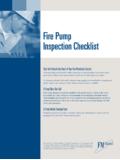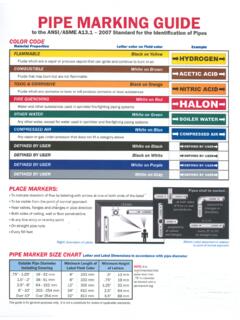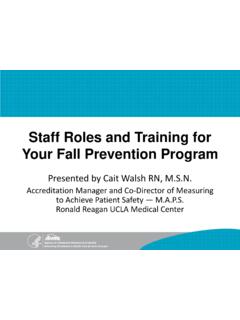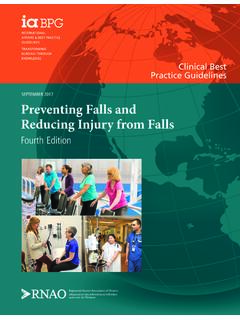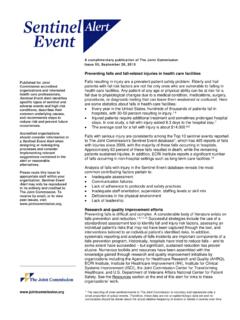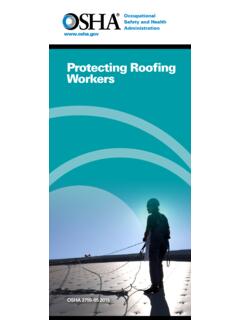Transcription of Slip, Trip & Fall Prevention Handbook - PPSA
1 Slip, Trip & fall Prevention Handbook This Prevention Handbook provides you with a basic understanding of what causes a slip, trip or fall and gives you some ideas on what you can do to stop these incidents occurring. Slips, trips and falls can happen in any workplace. They can occur at the entry of a building, in the kitchen, in cold rooms, on loading docks and even as you walk outside the building. More serious slips or trips together with the resulting falls may result in: sprains or strains broken bones when trying to break the fall a back injury due to the sudden and forceful impact during a fall burns if it occurs near hot surfaces or if the person is handling hot fluids cuts if it occurs near sharp objects Causes of slip, trips and falls There are various factors that contribute to the risk of slips and trips. Slips usually occur when there is a loss of grip between the shoe and the floor.
2 This commonly occurs when there is a contaminant between the shoe and the floor. Trips occur when a person s foot hits a low obstacle in the person s path, causing a loss of balance. Often, the obstacle is not easily visible or noticed. The following factors can contribute to the risk of slips and trips. It is usually a combination of these factors that create the risk of a slip or trip. Floor Contaminants Contaminants can be considered as anything that ends up on a floor. Contaminants can be wet such as water, oil or grease, or dry such as dust, metal shavings, plastic bags or off-cuts. Preventing floor contaminants is one of the best things you can do to prevent slips. Floor surfaces Floor surfaces require sufficient grip to prevent slipping, especially in areas which may become wet or contaminated. The greater the thickness or viscosity of the contaminants, the greater the slip resistance of the flooring required to protect against slipping.
3 Cleaning Cleaning affects every workplace and everyone in the workplace. Besides regular cleaning programs, everyone has a role keeping the work area clear and taking responsibility for their own spills. Floors need to be cleaned properly to ensure that: contaminants are effectively removed a build up of cleaning product residue is avoided the floor does not become too slippery floors maintain slip resistant properties (of non-slip flooring). Obstacles and other trip hazards Trips most often occur because of uneven flooring or cluttered walkways with low obstacles which are not easily visible or noticed. Common examples of low obstacles include trailing cables, uneven edges to flooring, gratings or covers, loose mats or carpet tiles and changes of floor surface level. Trips can be prevented by: good housekeeping practices ensuring the floor surface is in good order such as being free from holes, uneven surfaces, curled up floor coverings and floor mat edges avoiding any changes in floor surface level, or if this is not possible, highlighting these changes providing adequate storage facilities.
4 Environment, including lighting Poor lighting and distractions such as unfamiliar or unexpected loud noises, or extreme environmental conditions, such as extreme cold or heat, can impact a person noticing slip or trip hazards in their path. Adequate light levels without glare or shadowing is required to highlight potential slip or trip hazards. Other distractions, like those mentioned, should be minimized as much as possible. People and activity Work activities, the way the work is organized and attitudes to safety can affect the worker s ability to see or think about where they are going. For example, people hurrying, carrying large objects, pushing high trolleys or talking on a mobile phone could contribute to the cause of a slip or trip. Workers need to be able to maintain their balance when performing tasks and be able to recover if they slip or trip.
5 For example, when handling loads, workers should have full view of where they need to travel and should also have a free hand to hold onto a rail when walking down steps. Consideration should be given to: individuals physical attributes such as vision, balance and agility the work being carried out and how it is organized who will be walking through the area, including the public. Footwear Footwear plays an important role in reducing the risk of slips, trips and falls. Footwear should be: suitable for the type of work and work environment comfortable with an adequate non-slip sole and appropriate tread pattern checked regularly to ensure treads are not worn away or clogged with contaminants. CASE STUDIES Leads here, there and everywhere Case Study A worker carrying a box tripped and fell over an electrical lead that ran across the walkway in a manufacturing workshop.
6 During the fall he hit his head and shoulder on the corner of a piece of equipment. He sustained a serious shoulder injury which required major surgery. The company received a fine of $25,000. The injured worker was off work for three months and could not be replaced for this period due to a skilled labor shortage. An inspection of the work area showed that: electrical leads for equipment used near the walkway often ran across the walkway lighting in the workshop was poor so he could not clearly see the electrical lead workers often carried bulky items along the walkway, which obstructed their view of the floor. This incident could have been prevented by: positioning power outlets nearer to the point of use, to eliminate leads trailing across the walkway providing adequate lighting in the workshop for safe movement and to highlight obstructions on the floor reducing the size of the load being carried or providing mechanical aids, such as trolleys so that bulky items can be moved around the workshop without obstructing the workers vision.
7 Slippery kitchen floor Case Study Towards the end of a shift in a commercial kitchen, a worker slipped and fell sustaining serious burns after coming in contact with a tub of hot water. The tub of water was used for cleaning the floor at the end of the night. It was positioned beside the walkway near the deep fryer where in the same area several floor tiles were missing. This hollowed area allowed pooling of water and oil which was tracked throughout the kitchen. The kitchen floor was properly cleaned once at the end of the night. Workers were advised to wear enclosed shoes, however no advice was provided regarding the type of non-slip sole that should be worn. The employer was fined $17,500. The injured worker was off work for two months and the workplace had to recruit and train a new employee to fill in for this period. This incident could have been prevented by: replacing the missing tiles to stop contaminants pooling on the floor installing splash guards on the deep fryer to prevent oil splashing onto the floor placing covers over the deep fryer when it was not in use to prevent workers coming into contact with the hot oil putting in place spills management procedures so that spills are immediately attended to increasing the frequency of cleaning to minimize contaminants on the floor implementing a suitable footwear policy so that all workers wear shoes that have non-slip sole.
8 MANAGE SLIPS, TRIPS & FALLS The simplest way of preventing slips, trips and falls injuries in your workplace is to develop a risk management plan which identifies, assesses, controls and monitors safety hazards and risks. The following information, together with the slips, trips and falls risk management tool and worksheet at the back of this booklet, will help you develop a risk management plan and record your assessments. Identify hazards Identifying hazards is the first step to determine exactly where slips, trips and falls can or have occurred in your workplace. You can find out this information by talking to workers and supervisors, inspecting the premises, and reviewing records such as incident and injury reports as well as workers compensation claims. Another useful method is to sketch a layout of the work area and mark on it where slip and trip incidents or hazards have been reported.
9 Assess the risk The next step is to assess the slip or trip risks. Usually it is a combination of factors that create the risk. Consider the risk assessment questions in the right hand column of the risk management tool to assist in determining the level of risk. The red and amber section of the risk management tool can be helpful to determine the level of risk. As part of your assessment you should also consider: how many people are exposed the consequences of the slip or trip a slip or trip with or without a fall can be more serious if it occurs near hot, sharp or moving objects, or at a height, such as near stairs how often the situation occurs. Fix the problem Look at the assessed risks and decide what needs to be done to eliminate or reduce the risks and how quickly these measures need to be implemented. There are six types of control strategies to eliminate or reduce the risks and they are listed below in order of their effectiveness.
10 SAFETY CONTROLS Examples Eliminate the hazard. Remove slip and trip hazards at the design stage such as eliminating changes in floor levels; installing more power outlets through the floor and ceiling to avoid trailing cords. Substitution. Resurface floors. Isolation. Limit access to high risk areas. Minimise by redesign. Apply floor treatments to increase slip resistance; improve lighting; stop leaks from equipment or pipes; provide adequate drainage to prevent pooling of contaminants; clearly mark edges of steps and any changes in floor height. Administrative controls. Implement good housekeeping practices such as clear access ways; prompt spills management; use of signage or barricades for wet or slippery areas; safety training and supervision. Personal protective equipment. Wear suitable footwear. SELECT A SOLUTION Look at all the options available to you and select controls that will best reduce the risks.

